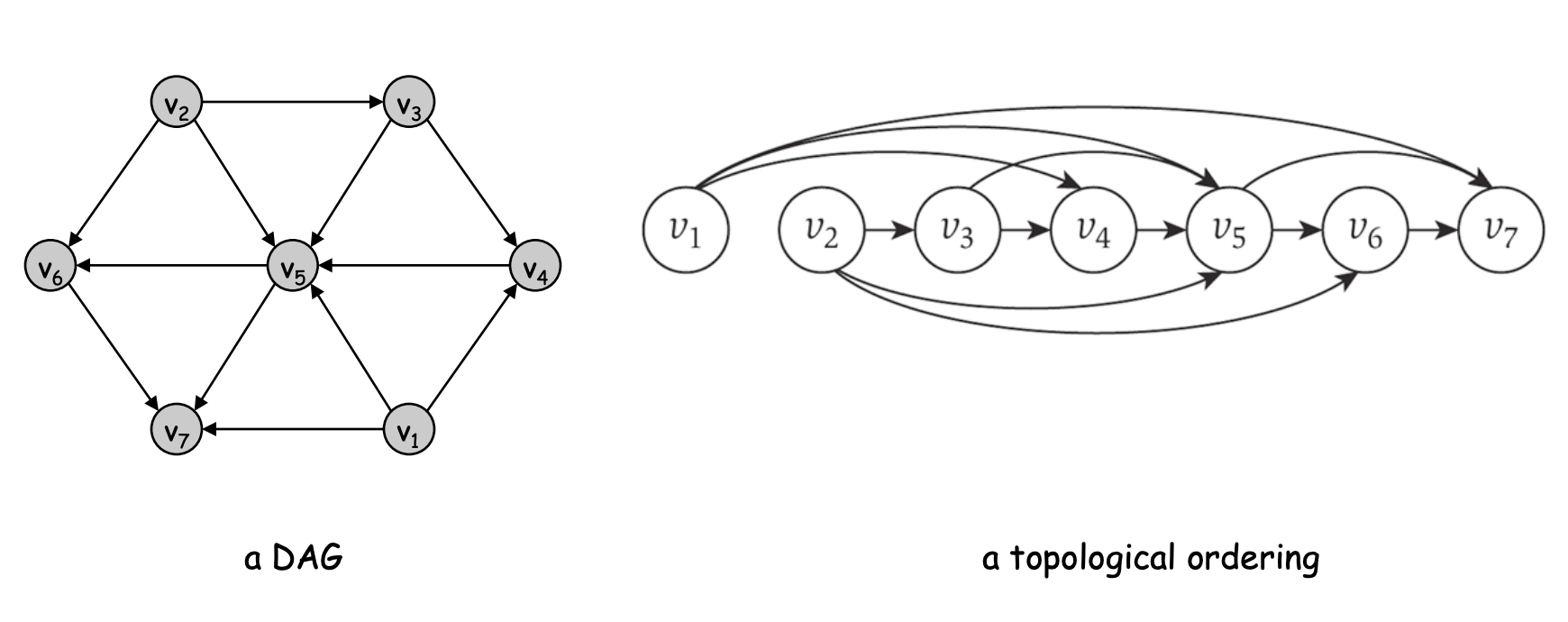L12 DAG
DAG(Directed Acyclic Graph), DAG's topological ordering and SCC(Strongly Connected Component).
Ref: 算法设计与分析(Algorithm design and analysis) by 黄宇.
Directed Acyclic Graph

An DAG is a directed graph that contains no directed cycles.
Topological Ordering for G=(V,E)
A topological order of a directed graph
Lemma1
Lemma1:
Proof:
==> : (by induction on n)
- Base case: true if n = 1.
- Given DAG on n > 1 nodes, find a node v with no incoming edges.
- G - { v } is a DAG, since deleting v cannot create cycles.
- By inductive hypothesis, G - { v } has a topological ordering.
- Place v first in topological ordering; then append nodes of G - { v } in topological order. This is valid since v has no incoming edges.
<== : (by contradiction)
- Suppose that G has a topological order v1, …, vn and that G also has a directed cycle C. Let's see what happens.
- Let vi be the lowest-indexed node in C, and let vj be the node just before vi ; thus (vj, vi ) is an edge.
- By our choice of i, we have i < j.
- On the other hand, since (vj, vi ) is an edge and v1, …, vn is a topological order, we must have j < i, a contradiction.

Lemma2
Lemma2: If G is a DAG, then G has a node with no incoming edges.
Proof: (by contradiction)
- Suppose that G is a DAG and every node has at least one incoming edge. Let's see what happens.
- Pick any node v, and begin following edges backward from v. Since v has at least one incoming edge (u, v) we can walk backward to u.
- Then, since u has at least one incoming edge (x, u), we can walk backward to x.
- Repeat until we visit a node, say w, twice.
- Let C denote the sequence of nodes encountered between successive visits to w. C is a cycle.

Compute Topologic Ordering
在某个集合
偏序集的有向图中没有长度大于一的环
拓扑序要求全序且无环.
- 如果有向图
- 成环等价于遍历过程中遇到了灰色节点.
- 如果有向图
"尽头"与DFS
DFS就是沿某条路径一直往下走,直到某个“尽头”节点。
假设
逻辑尽头
- 当一个节点的所有后续节点均已处理完毕时, 该节点就成为逻辑上的尽头节点。
- 逆拓扑排序时, 逻辑尽头节点的逆拓扑序号只需要分配当前未分配序号中最小的
- 分配拓扑序号的过程就成为不断找到逻辑结点的过程,这与DFS适合
- 在DFS-WRAPPER中,开始遍历之前定义一个全局变量
globalNum, 并初始化为n+1. - 在DFS框架的"遍历后处理"处,嵌入对拓扑排序的处理:
globalNum:=globalNum -1.v.topoNum:=globalNum.
- 在DFS-WRAPPER中,开始遍历之前定义一个全局变量
1
2
3
4
5
6
7TOPO-WRAPPER(G)
globalNum = n+1;
Color all nodes WHITE;
foreach node v in G do
if v.color = WHITE then
TOPO-ORDER(v);1
2
3
4
5
6
7
8
9
10
11TOPO-ORDER(v)
v.color = GRAY;
foreach neighbour w of v do
if w.color = WHITE then
TOPO-ORDER(w);
globalNUM := globalNum - 1;
v.topoNum := globalNum;
v.color = BLACK;- 当一个节点的所有后续节点均已处理完毕时, 该节点就成为逻辑上的尽头节点。
Complexity: O(m+n). m = number of edges, n = number of vertices.
Critical path analysis
Critical path in a Task Graph
Earliest start time( est ) for a task v
If v has no dependencies, the est is 0
If v has dependencies, the est is the maximum of the earliest finish time of its dependencies.
Earliest finish time( left ) for a task v
- For any task: eft = est + duration
Critical path in a project is a sequence of tasks:
- For any
- eft of
在DFS框架中嵌入相应处理
在"遍历前处理"处, 初始化该节点的最早开始时间, 并初始化关键路径相关信息
在结束邻接节点的处理返回的时候,检查是否要更新当前节点目前已知的最早开始时间.以及是否需要更新关键路径的相关信息
在"遍历后处理"处, 当前节点的est已确定, 则可以计算出当前节点的eft
1 | CRITICAL-PATH(v) //该算法同样需要WRAPPER来调度 |
Analysis
- Complexity
Connectivity of DAG
Strongly Connected
强连通(strongly connected): A DAG is strongly connected if every pair of nodes is mutually connected(->"connectivity" relation in graph).
- TL;DR: x和y是连通的 == 存在一条x -> y的长度未知的路径. (但长度不能为0)
Lemma. Let s be any node. G is strongly connected iff every node is reachable from s, and s is reachable from every node.
Pf:
==> : Follows from definition.
<== :
- Path from u to v: concatenate u-s path with s-v path.
- Path from v to u: concatenate v-s path with s-u path.
![DAG Strong Connectivity]()
Simply Connected
- 单连通(simply connected):A DAG is simply connected if 对图 G 中任意两个顶点 u 和 v, 存在从 u 到 v 的路径或从 v 到 u 的路径.
Weakly Connected
- 弱连通(weakly connected): A DAG is weakly connected if 忽略图 G 中每条有向边的方向, 得到的无向图(即有向图的基图)连通.
Detect Cycle in DAG
根据之前介绍的图的三种染色, 判断DAG是否有环就等价于判断在该图的遍历过程中是否遇到了灰色节点.
- 遇到灰色节点意味着在遍历该图时遇到了当前遍历树的祖先节点, 也就是成环.
1 | public class Graph<T> { |
Strongly Connected Component(SCC)
Condensation Graph
Condensation Graph: 把G中的每个强连通片收缩成一个点, 强连通片之间的边收缩成一条有向边,则得到G的收缩图
两个强连通片之间只能是单向可达(或者不可达).
DAG的Condensation Graph还是DAG.
Traverse of SCC
1 | SCC(G) |
Def:
For a DFS, the first vertex discovered in a strong component
推论:
The leader of
引理:
Each DFS tree of a digraph G contains only complete strong components of G, one or more.(即: 不可能一个强连通片中的节点一部分在某棵遍历树中,一部分不在)
Proof:
反证法: 设
x(若有的话), 比
- x只能为白色或黑色
在第二轮DFS中,当一个白色节点从栈中被POP出来时,它一定是其所在强连通片的首节点
Proof
第二轮DFS时,一个出栈的节点
